The Precision Components And Tooling Systems Market is estimated to be valued at USD 5.7 billion in 2025 and is projected to reach USD 10.2 billion by 2035, registering a compound annual growth rate (CAGR) of 6.0% over the forecast period.
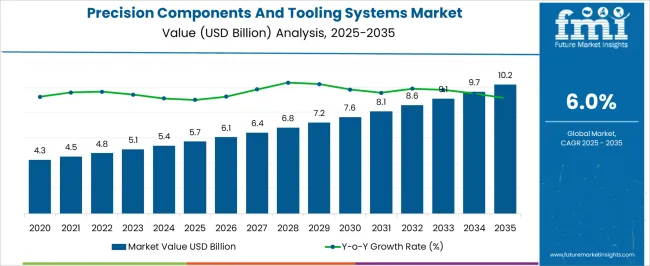
| Metric | Value |
|---|---|
| Precision Components And Tooling Systems Market Estimated Value in (2025 E) | USD 5.7 billion |
| Precision Components And Tooling Systems Market Forecast Value in (2035 F) | USD 10.2 billion |
| Forecast CAGR (2025 to 2035) | 6.0% |
The Precision Components and Tooling Systems market is experiencing steady growth, driven by the increasing demand for high-quality components in automotive, aerospace, industrial machinery, and electronics sectors. Adoption is being fueled by the need for precision, durability, and reliability in manufacturing processes, where even minor deviations can significantly impact product performance. Advanced tooling systems, including CNC machines, additive manufacturing, and high-precision jigs, are enhancing efficiency, reducing waste, and improving overall production quality.
The market is also supported by ongoing innovations in material science, enabling the development of lightweight, high-strength components. Increasing emphasis on reducing production costs and optimizing assembly lines has led to higher adoption of precision components.
Additionally, rising investments in automation, robotics, and smart factories are accelerating market growth As manufacturers continue to focus on operational excellence, quality assurance, and sustainability, the demand for advanced tooling systems and precision components is expected to expand consistently over the coming decade, with material innovation and process efficiency driving long-term growth.
The precision components and tooling systems market is segmented by material, metal subsegments, plastics subsegments, application, end use, and geographic regions. By material, precision components and tooling systems market is divided into Metal and Plastics. In terms of metal subsegments, precision components and tooling systems market is classified into Aluminium, Steel, Titanium, Copper, and Others. Based on plastics subsegments, precision components and tooling systems market is segmented into Polycarbonate, Teflon, Delrin, and Others. By application, precision components and tooling systems market is segmented into Stainless Steel & Titanium Components, Hardened Punches & Dies, WC-Co Components & Tools, Orthopaedic & Dental Implants, Grippers & Scissors, and Combat/Communication & Navigation Systems. By end use, precision components and tooling systems market is segmented into Defence & Aerospace, Medical, Watches & Measuring Instruments, Electronics & Communications, Automotive, Mining, Industrial Automation, and Others. Regionally, the precision components and tooling systems industry is classified into North America, Latin America, Western Europe, Eastern Europe, Balkan & Baltic Countries, Russia & Belarus, Central Asia, East Asia, South Asia & Pacific, and the Middle East & Africa.
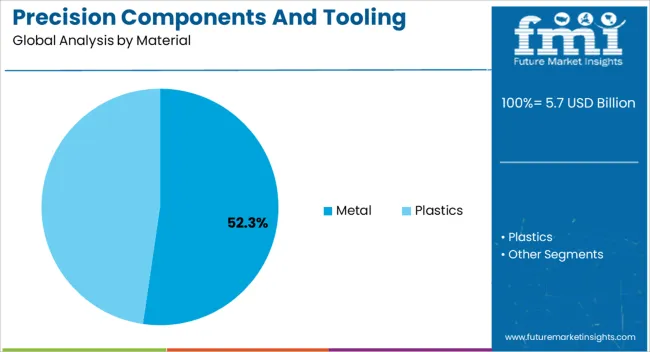
The metal material segment is projected to hold 52.3% of the market revenue in 2025, establishing it as the leading material type. Growth in this segment is being driven by the superior strength, durability, and thermal stability offered by metals, which are critical for high-performance applications across automotive, aerospace, and industrial sectors. Among metal subsegments, aluminium accounts for 28.7% of the market revenue, largely due to its lightweight, corrosion-resistant properties, and versatility in precision component manufacturing.
Aluminium enables reduced energy consumption during operation and supports high-strength-to-weight ratios, which are crucial for modern machinery and vehicles. The adoption of advanced processing technologies, including CNC machining and precision casting, has further reinforced its position.
Metal components allow for repeated high-precision production, consistent dimensional accuracy, and extended service life, providing significant cost advantages for manufacturers As industries continue to prioritize performance, reliability, and weight optimization, the metal segment, particularly aluminium, is expected to maintain its market leadership and remain a preferred choice for precision components.
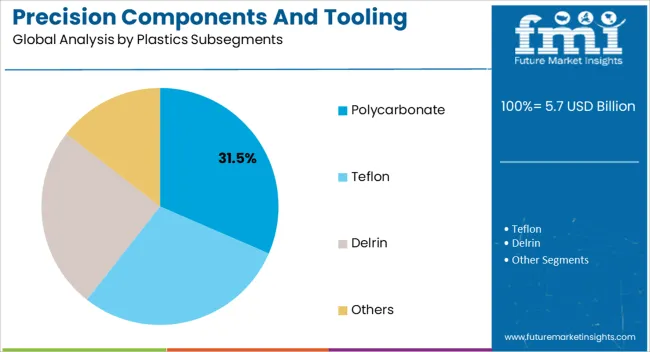
The plastics material segment is anticipated to hold a growing share of the market, supported by increasing demand for lightweight and cost-effective components. Among plastics subsegments, polycarbonate is projected to account for 31.5% of the market revenue in 2025, driven by its exceptional strength, impact resistance, and dimensional stability. Polycarbonate enables design flexibility, reduces component weight, and simplifies manufacturing processes, making it suitable for applications where metals may be impractical or overly heavy.
The ability to integrate plastics into precision tooling systems for complex geometries and non-conductive applications further strengthens adoption. Increasing emphasis on sustainability, recyclability, and energy-efficient production has also promoted the use of plastics in precision components.
The growing integration of plastics with hybrid assemblies, combining metals and polymers, is creating opportunities for optimized performance and cost savings As manufacturers continue to balance durability, weight reduction, and design flexibility, polycarbonate and other plastics are expected to maintain a significant share of the market, supporting overall growth in precision components and tooling systems.
Precision components and tooling systems have been used in fabricating and casting of constituent components used in areas such as industrial automation equipment, automotive parts, medical implant accessories and consumer goods. The components and tooling systems address a plethora of applications such as injection molding, metal stamping, munitions, medical –pharmaceutical accessories. The products involve standard as well as customized designs to address specific requirements by end use industries. Emphasis on product quality by efficient design & accreditation of the same has been practised by the manufacturers as a standard norm.
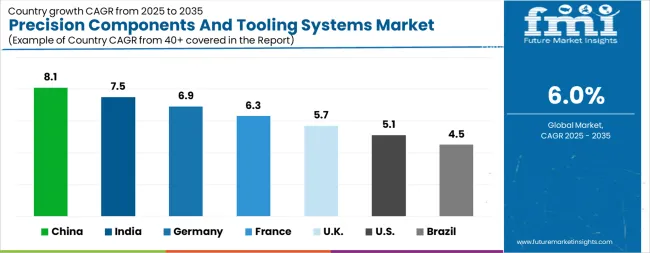
| Country | CAGR |
|---|---|
| China | 8.1% |
| India | 7.5% |
| Germany | 6.9% |
| France | 6.3% |
| UK | 5.7% |
| USA | 5.1% |
| Brazil | 4.5% |
The Precision Components And Tooling Systems Market is expected to register a CAGR of 6.0% during the forecast period, exhibiting varied country level momentum. China leads with the highest CAGR of 8.1%, followed by India at 7.5%. Developed markets such as Germany, France, and the UK continue to expand steadily, while the USA is likely to grow at consistent rates. Brazil posts the lowest CAGR at 4.5%, yet still underscores a broadly positive trajectory for the global Precision Components And Tooling Systems Market. In 2024, Germany held a dominant revenue in the Western Europe market and is expected to grow with a CAGR of 6.9%. The USA Precision Components And Tooling Systems Market is estimated to be valued at USD 2.2 billion in 2025 and is anticipated to reach a valuation of USD 3.6 billion by 2035. Sales are projected to rise at a CAGR of 5.1% over the forecast period between 2025 and 2035. While Japan and South Korea markets are estimated to be valued at USD 300.5 million and USD 178.0 million respectively in 2025.
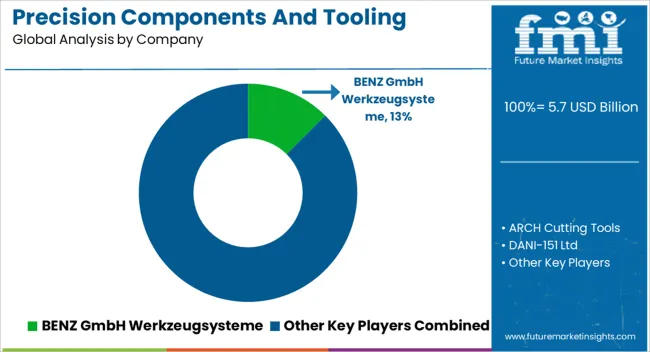
| Item | Value |
|---|---|
| Quantitative Units | USD 5.7 Billion |
| Material | Metal and Plastics |
| Metal Subsegments | Aluminium, Steel, Titanium, Copper, and Others |
| Plastics Subsegments | Polycarbonate, Teflon, Delrin, and Others |
| Application | Stainless Steel & Titanium Components, Hardened Punches & Dies, WC-Co Components & Tools, Orthopaedic & Dental Implants, Grippers & Scissors, and Combat/Communication & Navigation Systems |
| End Use | Defence & Aerospace, Medical, Watches & Measuring Instruments, Electronics & Communications, Automotive, Mining, Industrial Automation, and Others |
| Regions Covered | North America, Europe, Asia-Pacific, Latin America, Middle East & Africa |
| Country Covered | United States, Canada, Germany, France, United Kingdom, China, Japan, India, Brazil, South Africa |
| Key Companies Profiled | BENZ GmbH Werkzeugsysteme, ARCH Cutting Tools, DANI-151 Ltd, FRAISA SA, IMI plc, Ensinger Precision Components, Makino, Robert Bosch Tool Corporation, Evrika 7 Ltd, Botek Pr Zisionsbohrtechnik GmbH, TECHNOMECHAN -S. GAITANIDIS AND SONS, UMEC SL, Agathon AG, Nepean, and Sekishin Co Ltd |
The global precision components and tooling systems market is estimated to be valued at USD 5.7 billion in 2025.
The market size for the precision components and tooling systems market is projected to reach USD 10.2 billion by 2035.
The precision components and tooling systems market is expected to grow at a 6.0% CAGR between 2025 and 2035.
The key product types in precision components and tooling systems market are metal and plastics.
In terms of metal subsegments, aluminium segment to command 28.7% share in the precision components and tooling systems market in 2025.






Our Research Products

The "Full Research Suite" delivers actionable market intel, deep dives on markets or technologies, so clients act faster, cut risk, and unlock growth.

The Leaderboard benchmarks and ranks top vendors, classifying them as Established Leaders, Leading Challengers, or Disruptors & Challengers.

Locates where complements amplify value and substitutes erode it, forecasting net impact by horizon

We deliver granular, decision-grade intel: market sizing, 5-year forecasts, pricing, adoption, usage, revenue, and operational KPIs—plus competitor tracking, regulation, and value chains—across 60 countries broadly.

Spot the shifts before they hit your P&L. We track inflection points, adoption curves, pricing moves, and ecosystem plays to show where demand is heading, why it is changing, and what to do next across high-growth markets and disruptive tech

Real-time reads of user behavior. We track shifting priorities, perceptions of today’s and next-gen services, and provider experience, then pace how fast tech moves from trial to adoption, blending buyer, consumer, and channel inputs with social signals (#WhySwitch, #UX).

Partner with our analyst team to build a custom report designed around your business priorities. From analysing market trends to assessing competitors or crafting bespoke datasets, we tailor insights to your needs.
Supplier Intelligence
Discovery & Profiling
Capacity & Footprint
Performance & Risk
Compliance & Governance
Commercial Readiness
Who Supplies Whom
Scorecards & Shortlists
Playbooks & Docs
Category Intelligence
Definition & Scope
Demand & Use Cases
Cost Drivers
Market Structure
Supply Chain Map
Trade & Policy
Operating Norms
Deliverables
Buyer Intelligence
Account Basics
Spend & Scope
Procurement Model
Vendor Requirements
Terms & Policies
Entry Strategy
Pain Points & Triggers
Outputs
Pricing Analysis
Benchmarks
Trends
Should-Cost
Indexation
Landed Cost
Commercial Terms
Deliverables
Brand Analysis
Positioning & Value Prop
Share & Presence
Customer Evidence
Go-to-Market
Digital & Reputation
Compliance & Trust
KPIs & Gaps
Outputs
Full Research Suite comprises of:
Market outlook & trends analysis
Interviews & case studies
Strategic recommendations
Vendor profiles & capabilities analysis
5-year forecasts
8 regions and 60+ country-level data splits
Market segment data splits
12 months of continuous data updates
DELIVERED AS:
PDF EXCEL ONLINE
Precision Livestock Farming Market Size and Share Forecast Outlook 2025 to 2035
Precision Wire Drawing Service Market Size and Share Forecast Outlook 2025 to 2035
Precision Planting Market Size and Share Forecast Outlook 2025 to 2035
Precision Bearing Market Size and Share Forecast Outlook 2025 to 2035
Precision Laser Engraving Machines Market Size and Share Forecast Outlook 2025 to 2035
Precision Analog Potentiometer Market Size and Share Forecast Outlook 2025 to 2035
Precision Blanking Dies Market Size and Share Forecast Outlook 2025 to 2035
Precision Chemicals Market Size and Share Forecast Outlook 2025 to 2035
Precision Fermentation Ingredients Market Size and Share Forecast Outlook 2025 to 2035
Precision-Fermented Casein for QSR Pizza Cheese Market Analysis - Size, Share, and Forecast Outlook 2025 to 2035
Precision Ruminant Minerals Market Analysis - Size and Share Forecast Outlook 2025 to 2035
Precision Forestry Market Size and Share Forecast Outlook 2025 to 2035
Precision Stainless Steel Market Size and Share Forecast Outlook 2025 to 2035
Precision Machine For Polymers Market Size and Share Forecast Outlook 2025 to 2035
Precision Aquaculture Market Size and Share Forecast Outlook 2025 to 2035
Precision Fermented Functional Lipids Market Analysis Size and Share Forecast Outlook 2025 to 2035
Precision Gearbox Machinery Market Trends and Forecast 2025 to 2035
Precision Cancer Imaging Market Growth - Industry Trends & Forecast 2025 to 2035
Precision Poultry Nutrition Market – Growth, Demand & Livestock Trends
Precision Agriculture Market

Thank you!
You will receive an email from our Business Development Manager. Please be sure to check your SPAM/JUNK folder too.
Chat With
MaRIA